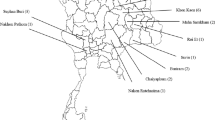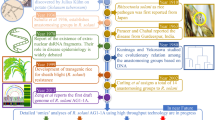Abstract
Rhizoctonia solani Kühn was originally reported causing sheath blight of rice in Japan at the beginning of this century (Miyake, 1910). However, rice sheath blight has developed into a major disease only during the past two decades. Nowadays, the disease is second only to, and often rivals, rice blast (Pyricularia oryzae) in terms of economic importance in many major rice-growing countries. The emergence of R. solani as a major rice pathogen has been attributed to the intensification of the rice-cropping system characterised by the development of new, short-statured, high-tillering, high-yielding varieties and an increase in nitrogen fertilisation inducing a favourable micro-climate for the pathogen. The rice sheath blight pathogen has been associated with isolates of one particular intraspecific group (ISG) of Rhizoctonia solani, anastomosis group (AG) 1 IA (Yamaguchi et al., 1984; Vijayan and Nair, 1985; Borthakur and Addy, 1988; Jones and Belmar, 1989), but diversity within this ISG appears to be much greater than was previously assumed (Liu and Sinclair, 1993). Detailed knowledge of pathogen characteristics at this taxonomic level is still lacking and has hampered understanding of the patho-systems.
Access this chapter
Tax calculation will be finalised at checkout
Purchases are for personal use only
Preview
Unable to display preview. Download preview PDF.
Similar content being viewed by others
References
Anderson, N. A. (1982) The genetics and pathology of Rhizoctonia solani, Annual Review of Phytopathology 20, 329–347.
Anonymous (1993) Country reports on crop loss due to sheath blight, in: Rice sheath blight management workshop,. China National Rice Research Institute, Hangzhou, China, 11–15 October 1993, IRRI, Philippines.
Anuratha, C.S., Zen-KuoChang, Cole, K.C., Mew, T., Muthukishnan, S. and Zen, K.C. (1996) Induction of chitinases and ß-1,3-glucanases in Rhizoctonia solani-infected rice plants: isolation of infection-related chitinase cDNA clone, Physiologia-Plantarum 97, 39–46.
Baker, K.F. (1970) Types of Rhizoctonia diseases and their occurrence, in J.R. Parmeter Jr. (ed.), Rhizoctonia solani: Biology and pathology, University of California Press, Berkeley, Los Angeles.
Banniza, S., Rutherford, M.A., Bridge, P.D., Holderness, M and Mordue, J.E.M. (1996) Biological characterisation of Rhizoctonia solani in rice-based cropping systems. Proceedings Brighton Crop Protection Conference. Vol.1:399–404,The British Crop Protection Council, Farnham
Banniza, S., Bridge, P.D., Holderness, M., Rutherford, M.A. and Simons, S.A. (1997) Assessments of characteristics for determining pathogen populations of Rhizoctonia solani in rice-based cropping systems, in: Proceedings of the 4th EFPP-Symposium on ‘Diagnosis and Identification of Plant Pathogens’
Bera, S. and Purkayastha, R.P. (1995) Differential response of pathogenesis-related proteins to phytoalexin elicitors and its impact on sheath blight disease in rice, Indian Journal of Experimental Biology 32, 902–905.
Borthakur, B.K. and Addy, S.K. (1988) Anastomosis grouping in isolates of Rhizoctonia solani causing sheath blight disease, Indian Phytopathology 41, 351–354.
Bruns, T.D., White, T.J. and Taylor, J.W. (1991) Fungal molecular systematics, Annual Review of Ecological Systematics 22, 525–564.
Cruickshank, R.H. (1990) Pectic zymograms as criteria in taxonomy of Rhizoctonia, Mycological Research 94, 938–946.
Cu, R.M., Mew, T.W., Cassman, K.G. and Teng, P.S. (1996) Effect of sheath blight on yield in tropical, intensive rice production system, Plant Disease 80, 1103–1108.
Damicone, J.P., Patel, M.V. and Moore, W.F. (1993) Density of sclerotia of Rhizoctonia solani and incidence of sheath blight in rice fields in Mississippi, Plant Disease 77, 257–260.
Dodman, R.L. and Flentje, N.T. (1970) The mechanism and physiology of plant penetration by Rhizoctonia solani, in J.R.Parmeter Jr. (ed.), Rhizoctonia solani, biology and pathology, University of California Press, Berkley, pp. 149–160.
Egger, K.N. (1992) Analysis of fungal population structure using molecular techniques, in G.0 Caroll and D.T. Wicklow (eds.), The fungal community. Its organization and role in the ecosystem, Marcel Dekker, New York.
Flentje, N.T., Dodman, R.L. and Kerr, A. (1963) The mechanism of host penetration by Thanatephorus cucumeris, Australian Journal of Biological Science 16, 784–799.
Foroutan, A. and Rahimian, H. (1991) Distribution and characteristics of isolates of R. solani and R. oryzaesativae in rice fields of Mazandaran, Iranian Journal of Plant Pathology 27, 1–4.
Gangopadhyay, S. and Chakrabarti, N.K. (1982) Sheath blight on rice, Review of Plant Pathology 61, 451460.
Groth, D.E. and Nowick,E.M. (1992) Selection for resistance to rice sheath blight through number of infection cushions and lesion type, Plant Disease 76, 721–723.
Jabaji-Hare, S.H., Meller, Y., Gill, S. and Charest, P.M. (1990) Investigation of genetic relatedness among anastomosis groups of Rhizoctonia solani using cloned DNA probes, Canadian Journal of Plant Pathology 12, 393–404.
Johnk, J.S. and Jones, R.K. (1992) Determination of whole-cell fatty acids in isolates of Rhizoctonia solani AG-1 IA, Phytopathology 82, 68–72.
Johnk, J.S. and Jones, R.K. (1993) Differentiation of populations of AG-2–2 of Rhizoctonia solani by analysis of cellular fatty acids, Phytopathology 83, 278–283.
Johnk, J.S. and Jones, R.K., (1994): Comparison of whole-cell fatty acid compositions in intraspecific groups of Rhizoctonia solani AG-I, Phytopathology 84, 271–275.
Jones, R.K. and Belmar, S.B., (1989): Characterisation and pathogenicity of Rhizoctonia spp, isolated from rice, soybean, and other crops grown in rotation with rice in Texas, Plant Disease 73, 1004–1010.
Kim, W.G., Kim, C.K. and Yu, S.H. (1988) Anastomosis grouping and cultural characteristics of isolates of Rhizoctonia solani Kühn from sclerotia overwintered in paddy fields, Korean Journal of Plant Pathology 4, 136–142.
Kuninaga, S. and Yokosawa, R. (1982) DNA base sequence homology in Rhizoctonia solani Kühn I. Genetic relatedness within anastomosis group 1, Annals of the Phytopathological Society of Japan 48, 659667.
Lee, F.N., (1980): Number, viability and buoyancy of Rhizoctonia solani sclerotia in Arkansas rice fields, Plant Disease 64, 298–300.
Lee, F. N. and Rush, M.C. (1983) Rice sheath blight: A major rice disease, Plant Disease 67, 829–832. Lin, W., Anuratha, C.S., Dana, K., Potrykus, I., Muthukrishnan, S. and Datta, S.K. (1995) Genetic Engineering of rice for resistance to sheath blight, Biotechnology 13, 686–691.
Liu, Z.L. and Sinclair, J.B. (1993) Differentiation of intraspecific groups within anastomosis group 1 of Rhizoctonia solani using ribosomal DNA internal transcribed spacer and isozyme comparison, Canadian Journal of Plant Pathology 15, 272–280.
Marshall, D.S. and Rush, M.C., (1980a): Infection cushion formation on rice sheaths by Rhizoctonia solani. Phytopathology, 70: 947–950.
Marshall, D.S. and Rush, M.C. (1980b) Relation between infection by Rhizoctonia solani and R. oryzae and disease severity in rice, Phytopathology 70, 941–946.
Massaquoi, R.C. and Rush, M.C., (1987): Relationship of quantity of epicuticular wax to resistance of rice to sheath blight. [Abstract] Phytopathology, 77: 1723
Matsuyama, N., Moromizato, Z., Ogoshi, A. and Wakimoto, S. (1978) Grouping Rhizoctonia solani with non-specific esterase zymogram, Annals of the Phytopathological Society of Japan 44, 652–658.
Mew, T.W. and Rosales, A.M. (1986) Bacterization of rice plants for the control of sheath blight caused by Rhizoctonia solani, Phytopathology 76, 1260–1264.
Miyake, I. (1910) Studien über die Pilze der Reispflanze in Japan, Journal of the College of Agriculture, Imperial University of Tokyo 2, 237–276.
Ogoshi, A. and Ui, T. (1983) Diversity of clones within an anastomosis group of Rhizoctonia solani Kühn in a field, Annals of the Phytopathological Society of Japan 49, 239–245.
Ogoshi, A., Cook, R.J. and Bassett, E.N. (1990) Rhizoctonia species and anastomosis groups causing root rot of wheat and barley in the Pacific Northwest, Phytopathology 80, 784–788.
Ou, S.H. (1985) Rice diseases, Commonwealth Mycological Institute, Great Britain.
Palo, M.A. (1926) Rhizoctonia disease of rice: I. Study of the disease and of the influence of certain conditions upon the viability of the sclerotial bodies of the causal fungus, Philippine Agriculturist 15, 361–375.
Park, A.R.C.S. and Bertus, L.S. (1932) Sclerotial diseases of rice in Ceylon. 1. Rhizoctonia solani Kühn, Ceylon Journal of Science All, 319–331.
Parmeter, J.R.,Jr., Sherwood, R.T. and Platt, W.D. (1969) Anastomosis grouping of Thanatephorus cucumeris, Phytopathology 59, 1270–1278.
Parmeter, J.R.,Jr., and Whitney, H.S. (1970) Taxonomy and Nomenclature of the imperfect state, in J.R. Parmeter, Jr (ed.), Rhizoctonia solani: Biology and pathology, University of California Press, Berkeley.
Rawn, J.D. (1983) Biochemistry,Harper Row Publishers Inc.
Reinking, O.A. (1918) Philippine economic plant diseases, The Philippine Journal of Science A13, 165–274.
Savary, S., Castilla, N.P., Elazegui, F.A., McLaren, C.G., Ynalvez, M.A. and Teng, P.S. (1995) Direct and indirect effects of nitrogen supply and disease source structure on rice sheath blight spread,Phytopathology 85, 959–965.
Shahjahan, A.K.M., Fabeller, N. and Mew, T.W., (1990): Effect of crop management practices on the sclerotia dynamics of Rhizoctonia solani in upland rice, Bangladesh Journal of Plant Pathology 6, 19–23.
Sherwood, R. T. (1969) Morphology and pathology of four anastomosis groups of Thanatephorus cucumeris, Phytopathology 59, 1924–1929.
Shirai, M. (1906) On Hypochnus sasakii n. sp., [Abstract] Botanical Magazine, Tokyo 20, 319–323.
Singh, S.K., Satyanarayana, K. and Reddy, A.P.K. (1990) Studies on morphology, growth habit, hyphal anastomosis and virulence pattern of five isolates of sheath blight pathogen of rice, Indian Phytopathology 43, 368–371.
Sneh, B., Burpee, L. and Ogoshi, A., (1991) Identification of Rhizoctonia species, APS Press
Minnesota.Vijayan, M. and Nair, C. M. (1985) Anastomosis grouping of isolates of Rhizoctonia solani Kühn (Thanatephorus cucumeris (Frank) Donk) causing sheath blight of rice Current Science 54, 89–291.
Vilgalys, R. (1988) Genetic relatedness among anastomosis groups in Rhizoctonia as measured by DNA DNA hybridization, Phytopathology78, 698–702.
Vilgalys, R. and Gonzalez, D. (1990) Ribosomal DNA restriction length polymorphisms in Rhizoctonia solani, Phytopathology 80, 151–158.
Vilgalys, R. and Cubeta, M.A. (1994) Molecular systematics and population biology of Rhizoctonia, Annual Review of Phytopathology 32, 135–155.
Wei, C.T. (1934) Rhizoctonia sheath blight of rice, Bulletin of the College of Agriculture and Forestry, University of Nanking 15, 1–21.
Yamaguchi, T., Kardin, M.K., Wagiman and Tantera, D.M. (1984) Hyphal anastomosis groups of Rhizoctonia solani Kühn in Indonesia, Penelitian Pertanian 4, 26–28.
Zuber, M. and Manibhushanrao, K. (1982) Studies on comparative gel electrophoretic patterns of proteins and enzymes from isolates of Rhizoctonia solani causing sheath blight disease in rice. Canadian Journal of Microbiology 28, 762–771.
Author information
Authors and Affiliations
Rights and permissions
Copyright information
© 2001 Springer Science+Business Media Dordrecht
About this chapter
Cite this chapter
Banniza, S., Holderness, M. (2001). Rice Sheath Blight — Pathogen Biology and Diversity. In: Major Fungal Diseases of Rice. Springer, Dordrecht. https://doi.org/10.1007/978-94-017-2157-8_14
Download citation
DOI: https://doi.org/10.1007/978-94-017-2157-8_14
Publisher Name: Springer, Dordrecht
Print ISBN: 978-90-481-5835-5
Online ISBN: 978-94-017-2157-8
eBook Packages: Springer Book Archive




